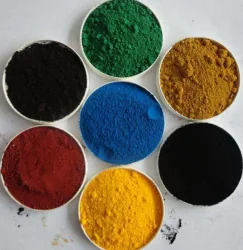Characteristics and applications of iron oxide pigments
2024-02-19
Iron oxide pigments are a group of inorganic pigments derived from iron compounds. They are widely used in various industries due to their natural earthy colors, chemical stability, and resistance to fading. Here are some key characteristics and applications of iron oxide pigments:
1. Colors:
- Red Iron Oxide (Fe2O3): This pigment produces shades of red and brown. It is commonly used in paints, coatings, and construction materials.
- Yellow Iron Oxide (FeOOH or Fe2O3·H2O): Yellow iron oxide provides yellow to brownish hues. It is often used in paints, plastics, and ceramics.
- Black Iron Oxide (Fe3O4): Also known as magnetite, black iron oxide produces black to dark brown colors. It is used in magnetic recording media, toners, and as a pigment in inks and coatings.
2. Characteristics:
- Chemical Stability: Iron oxide pigments are chemically stable and resistant to environmental factors, making them suitable for long-lasting applications.
- Opacity: Iron oxide pigments offer good hiding power, contributing to their use in coatings and paints where coverage is essential.
- UV Stability: They generally have good UV stability, which helps prevent color fading when exposed to sunlight.
3. Applications:
- Paints and Coatings: Iron oxide pigments are extensively used in architectural paints, industrial coatings, and automotive finishes due to their durability and color stability.
- Construction Materials: These pigments are common in the coloring of concrete, bricks, tiles, and other construction materials. They provide natural earthy tones and enhance the aesthetic appeal of structures.
- Plastics and Rubber: Iron oxide pigments are employed in the coloring of plastic products, PVC, rubber, and other polymers.
- Inks: Black iron oxide is used as a pigment in inks, including printing inks and toners.
4. Natural vs. Synthetic:
- Iron oxide pigments can be obtained naturally from minerals or synthesized through chemical processes.
- Natural iron oxide pigments are often mined from deposits of hematite, goethite, or magnetite. Synthetic iron oxide pigments are manufactured using iron salts or waste iron by-products
5. Regulatory Considerations:
- While iron oxide pigments are generally considered safe and stable, there may be variations in toxicity depending on the specific type and impurities.
- Regulatory agencies may impose limits on certain heavy metal content, especially for pigments used in consumer products like cosmetics.
6. Magnetic Properties:
- Black iron oxide (magnetite) is magnetic, and its magnetic properties find applications in magnetic recording media, magnetic inks, and as a magnetic pigment in toners.
It's important for manufacturers to carefully choose iron oxide pigments based on the intended application, considering factors such as color requirements, chemical compatibility, and regulatory compliance. Additionally, advances in technology have led to the development of more sustainable and eco-friendly iron oxide pigments.



